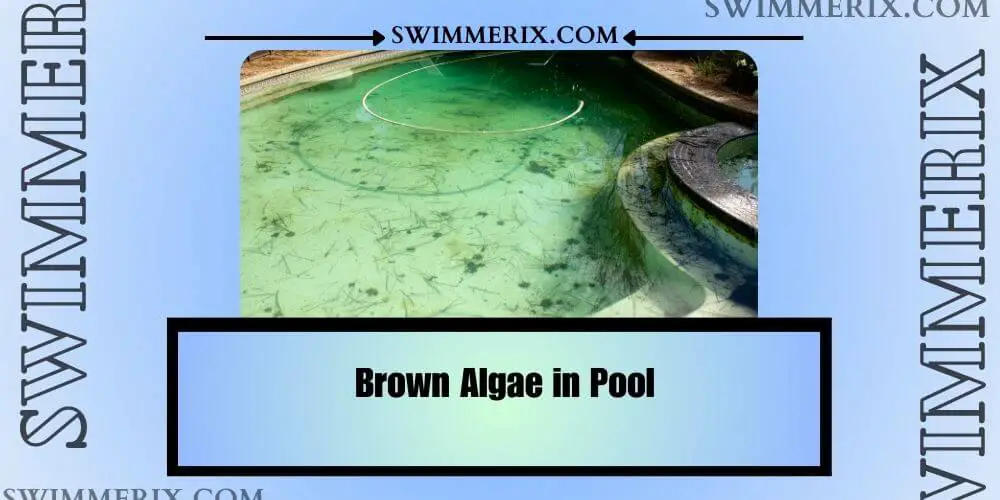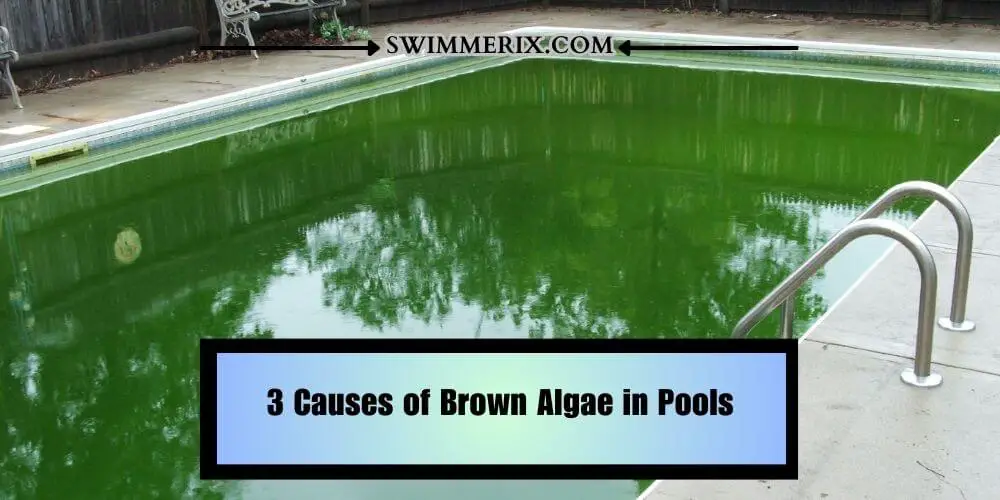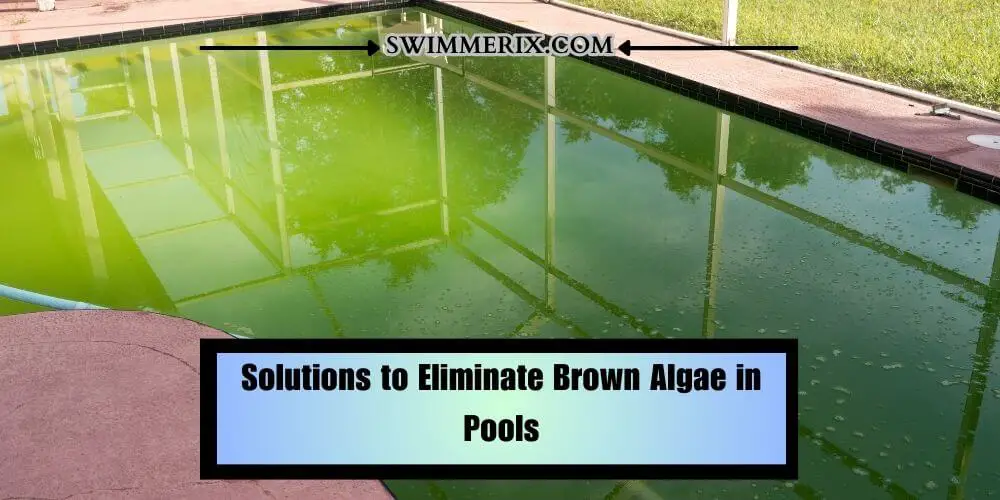
Having a swimming pool is not a delightful luxury but also quite a cool escape during hot summer days. However, when you encounter brown algae in a pool, it becomes a frustrating issue to look at & resolve.
Brown algae, or diatom, is quite an unsightly mess in a sparkling pool. Therefore, if you want to eliminate ‘brown algae in the pool,’ this article is for you. In this article, I will discuss the cause behind brown algae in pools and explore effective solutions for its elimination while discussing the preventive measure to keep your pool algae-free.
In a swimming pool, brown algae can present as semi-patches on the pool surface, including walls, steps & even pool equipment. It can quickly spread if left unaddressed, making the pool water cloudy and uninviting. Therefore, removing this issue is very important to maintain an oasis. So, let’s discuss the causes of brown algae in pools.
3 Causes of Brown Algae in Pools

To effectively tackle brown algae growth (Phaeophyta), it is essential to understand the underlying causes. Below, we’ll explore some common culprits responsible for the proliferation of brown algae in pools.
Insufficient Chlorine Levels
Well, I have thoroughly researched the primary cause of brown algae growth in pools. Throughout my research, I learned that inadequate chlorine levels are the primary reason for brown algae growth in the water since chlorine plays a crucial role in sanitizing the water and preventing the growth of algae & other organisms.
Hence, if you are not providing adequate chlorine levels to the pool water, bacteria & algae growth can thrive in such a favorable environment. A study by the Centers for disease control & Prevention emphasizes the importance of maintaining a free chlorine concentration of 1-3 parts per million to prevent algae growth and ensure a healthy pool environment.
Not only low chlorine levels but also pH level imbalances & alkalinity are a few factors that may affect the effectiveness of chlorine in control in algae growth as well.
Plus, it is important that you pay attention to regular pool water testing using a reliable testing kit & ensure balanced water parameters & chemical concentration for crystal clear water & prevent bacteria or algae.
Poor Water Circulation & Filtration
Another factor that might contribute to brown algae growth in the Pool can be inadequate water circulation & filtration. I recommend you check your filter system & the water circulation.
Insufficient water circulation usually creates stagnant areas in the Pool, which is a perfect breeding ground for algae, especially when compared to warmer temperatures. Additionally, if you are not maintaining a proper filtration system, it might fail to remove debris or microscopic organisms from the water, allowing the algae to thrive more effectively.
If you want to combat this issue, ensure your pool circulation & filtration system are working in optimal condition. According to the Maricopa County (.gov), a turnover rate of at least one complete pool water circulation within 8 hours is highly recommended to maintain proper water quality.
In addition to this, make sure that you are also regularly cleaning & maintaining the pool skimmer, along with a filter, to ensure efficient removal of debris & prevent clogging, which might compromise the filtration as well.
Warm Water Temperatures
As I told you in the above section, stagnant water, and warm water conditions allow a perfect breeding ground for algae growth. Therefore, having a higher water temperature might contribute to their growth.
As temperature rises, algae can reproduce more rapidly, leading to an increase in algae blooms. Surprisingly, warmer water temperatures alone may not directly cause brown algae growth but can create an environment that favors their proliferation.
As per Renewable and Sustainable Energy Reviews, certain species of brown algae exhibiting optimal growth rates in water temperatures ranging between 20° C to 30° C.
Therefore, to mitigate this factor, consider implementing strategies like controlling water temperatures using pool cover to reduce overheating/heat absorption during hot periods or incorporating shade around your pool area.
Solutions to Eliminate Brown Algae in Pools

After knowing, what would be the potential causes of brown algae growth, let’s explore some effective solutions that can help you eliminate this unwelcoming invader from your Pool.
Shock Treatment
The most common method that you can use to eliminate brown algae is shock treatment. Ensure you shock the Pool by adding a concentrated dose of chlorine. Alternatively, you can offer nonchlorine shock to the water to raise the chlorine level, effectively killing the algae. Also, check this post to learn “Should You Filter or Recirculate Pool When Shocking“.
But, if you are performing a shock treatment, you must adhere to the manufacturer’s instructions & recommended dosage. This will not only ensure the treatment highly effective but also prevent adverse effects on the Pool or the swimmers.
Below, I mention the recommended shock treatment dosage according to the pool volume. You should also note that harsh treatments are known to raise chlorine levels to levels unsafe for swimming temporarily. Therefore, you must wait until the chlorine level returns to a safe range before entering the Pool or letting someone use it. It’s common for pool to turn cloudy after shock, and this should go away on its own after couple of hours. But, if the issue persist, check my indepth guide on “Why is the Pool Cloudy After Shock“
| Pool Volume | Chlorine Shock Dosage |
| Less than 10,000 gallons | 1 pound of shock per 10,000 gallons |
| 10,000 to 20,000 gallons | 2 pounds of shock per 10,000 gallons |
| More than 20,000 gallons | 3 pounds of shock per 10,000 gallons |
Or, you can check this post for more accurate understanding “How Much Liquid Chlorine Do You Need for Your 15000 Gallon Pool”
Brushing & Scrubbing
You must also physically remove the ground algae from your pool surface for effective elimination. To do this, consider brushing & scrubbing the pool walls, steps & other effective areas to dislodge the algae & prevent its reattachment.
When brushing the Pool, make sure that you also focus on areas where algae growth is more visible. Consider using a pool brush that comes with stiff bristle & scrub vigorously to ensure thorough removal.
Also, make sure that you pay attention to corners, crevices & hard reach areas, as algae accumulate in these spots. If you incorporate a regular brushing routine in pool maintenance, you can effectively prevent the recurrence of brown algae growth.
Algaecide Treatment
In some cases, shock treatment & brushing may not completely eradicate the stubborn brown algae growth in your Pool. If you find removing brown algae from the Pool hard, you might have to use algaecides. But Too Much Algaecide in Pool can be detrimental. So, use it in moderation or as directed by professionals.
Algaeides are an effective solution that eliminates the algae. However, make sure you also employ shock treatment & brush manual brushing. Returning to the point, algaecides are chemical treatments specially formulated to target & kill algae.
There are also different types of algaecides, including copper-based & nonmetallic algaecides. Therefore, make sure to choose the right type of algaecides. In the case of brown algae, you should be using copper-based algaecides as copper iron effectively inhibits algae growth. Some also practice home based treatments like bleach. But the question is “Will Bleach Kill Algae in a Pool“
Plus, If you are using algaecides, be extra careful with following the manufacturing recommendations & instructions regarding dosage & application. It would help never to misuse or overuse algaecides that may lead to imbalanced water chemistry or other issues.
Preventive Measures for Brown Algae Growth in Pools
Regular Testing & Balancing of Pool Water Chemistry
If you want to prevent algae growth, pay attention to the proper maintenance of your pool water chemistry. If you pay attention to the regular testing & balancing of the pH alkalinity & calcium hardness level of your Pool, it might.
In that case, it becomes a favorable environment for algae to thrive. Therefore, ensure that you are maintaining & ideal pool water chemistry ranges similar to those mentioned below in the table.
| Parameter | Ideal Range |
| pH | 7.4-7.6 |
| Total Alkalinity | 80-120 ppm |
| Calcium Hardness | 200-400 ppm |
| Free Chlorine | 1-3 ppm |
| Combined Chlorine | 0 ppm |
| Cyanuric Acid | 30-50 ppm (for outdoor pools) |
Note: You must regularly monitor this parameter using a reliable pool water testing kit & adjust as necessary to maintain optimal conditions for swimming while inhibiting algae growth.
Routine Pool Maintenance & Cleaning
As experts suggest, regular pool maintenance & cleaning is important in preventing brown algae growth. Therefore, ensure that you also incorporate a routine cleaning schedule, including skimming the pool surface to remove the debris, cleaning out the skimmer & pump basket, and vacuuming the pool floor. In addition, perform regular black washing & cleaning of the pool filter to ensure efficient filtration & remove trapped debris that may contribute to algae growth.
Adequate Filtration & Circulation
If you want to maintain clean & algae-free pool water, pay attention to the proper filtration & circulation system as well. Also, sometimes you also find Pool Sand Filter Not Filtering Algae properly/effectively. You must use the correct size of pool filtration system for your pool volume & make sure it’s in good working condition.
To prolong its lifespan, make sure to regularly clean & backwash the filter to remove trapped debris & maintain optimal flow rates. Also, it is important to promote adequate water circulation by strategically positioning return jets using water features or waterfalls to agitate the water surface and running the pump pool for an appropriate duration each day.
Regular Brushing & Vacuuming
Make sure you are also brushing & vacuuming the pool surface regularly to reduce the likelihood of algae growth. Not only should you physically remove the debris & algae spores, but you should also consider introducing algaecide to minimize their opportunity to establish themselves in the Pool.
I usually like to brush my pool wall, steps, & other surfaces at least once weekly. You should also maintain a maintenance schedule & pay attention to areas prone to algae buildup. Also, follow up with vacuuming to remove any dislodged algae & debris from the pool floor.
UV Sanitation and/or Ozone Treatment
UV sanitation & ozone systems can be a valuable addition to your pool disinfection regimen if you consider installing one. This kind of technology is known to use ultraviolet Ray light or ozone gas to destroy algae & other microorganisms, helping to maintain clean & algae-free pool water.
UV sanitation systems? They expose the pool water to UV light, effectively neutralizing algae & other microorganisms. On the other hand, ozone treatment involves injecting ozone gas into the water, which further acts as a powerful oxidizer & kills algae.
Both UV sanitation & ozone treatments effectively offer an extra layer of protection against algae growth. However, ensure that you also consider proper installation operation & maintenance for optimal effectiveness.
Conclusion
Brown algae in pools can be a frustrating & insightful problem for pool owners. Therefore, I have given my best to help you understand the potential cause and an effective solution you can implement to get rid of these brown algae.
Make sure that you adopt preventive measures to maintain an algae-free pool environment by ensuring adequate chlorine levels, promoting water circulation & filtration, controlling water temperatures, and implementing regular maintenance practices to enjoy a clean & inviting pool all season long.
Also, note that Prevention is considered to be the best strategy when it comes to algae growth. Also, make sure to be attentive & keep an eye on your Pool’s water chemistry to maintain a proper balance for a safe swimming experience.
Maintaining a regular cleaning & maintenance routine can help you keep the brown algae at bay. I hope I have given you enough information regarding what to do about brown algae in pools. If you find this article helpful, then consider sharing.
Your share will help many people learn the potential cause & solution for brown algae in pools. Do check my other helpful guide on pool care & maintenance. See you in the next post, till then, take care & goodbye.

